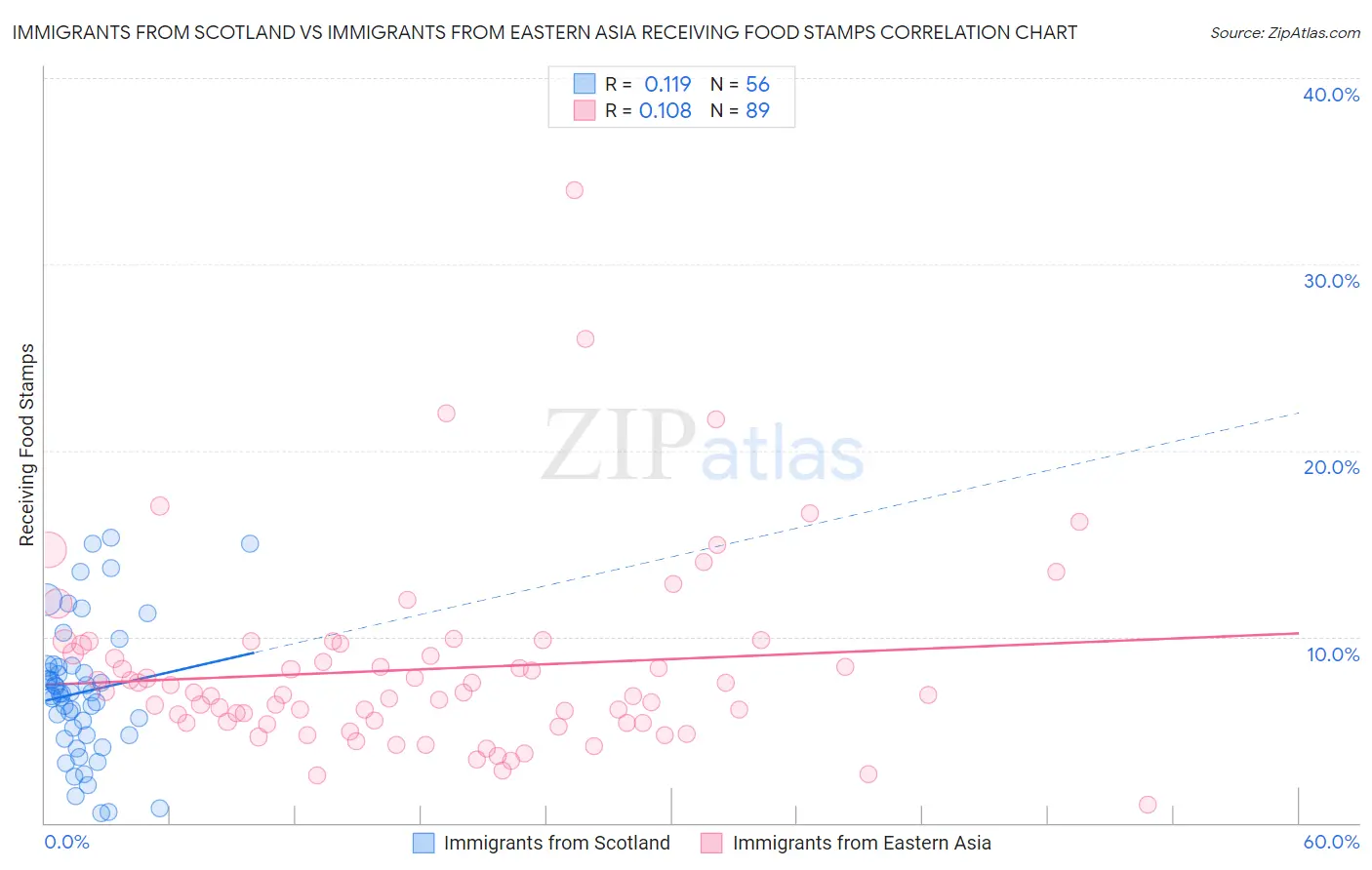Immigrants from Scotland vs Immigrants from Eastern Asia Receiving Food Stamps
COMPARE
Immigrants from Scotland
Immigrants from Eastern Asia
Receiving Food Stamps
Receiving Food Stamps Comparison
Immigrants from Scotland
Immigrants from Eastern Asia
9.0%
RECEIVING FOOD STAMPS
99.9/ 100
METRIC RATING
17th/ 347
METRIC RANK
9.3%
RECEIVING FOOD STAMPS
99.7/ 100
METRIC RATING
31st/ 347
METRIC RANK
Immigrants from Scotland vs Immigrants from Eastern Asia Receiving Food Stamps Correlation Chart
The statistical analysis conducted on geographies consisting of 196,125,913 people shows a poor positive correlation between the proportion of Immigrants from Scotland and percentage of population receiving government assistance and/or food stamps in the United States with a correlation coefficient (R) of 0.119 and weighted average of 9.0%. Similarly, the statistical analysis conducted on geographies consisting of 497,431,839 people shows a poor positive correlation between the proportion of Immigrants from Eastern Asia and percentage of population receiving government assistance and/or food stamps in the United States with a correlation coefficient (R) of 0.108 and weighted average of 9.3%, a difference of 3.6%.

Receiving Food Stamps Correlation Summary
| Measurement | Immigrants from Scotland | Immigrants from Eastern Asia |
| Minimum | 0.50% | 1.0% |
| Maximum | 15.3% | 34.0% |
| Range | 14.8% | 33.0% |
| Mean | 7.0% | 8.3% |
| Median | 6.9% | 7.0% |
| Interquartile 25% (IQ1) | 4.7% | 5.4% |
| Interquartile 75% (IQ3) | 8.4% | 9.6% |
| Interquartile Range (IQR) | 3.7% | 4.2% |
| Standard Deviation (Sample) | 3.6% | 5.1% |
| Standard Deviation (Population) | 3.6% | 5.1% |
Demographics Similar to Immigrants from Scotland and Immigrants from Eastern Asia by Receiving Food Stamps
In terms of receiving food stamps, the demographic groups most similar to Immigrants from Scotland are Immigrants from Japan (9.0%, a difference of 0.15%), Norwegian (9.0%, a difference of 0.43%), Danish (9.0%, a difference of 0.45%), Immigrants from Hong Kong (9.1%, a difference of 1.0%), and Maltese (8.9%, a difference of 1.1%). Similarly, the demographic groups most similar to Immigrants from Eastern Asia are Bolivian (9.3%, a difference of 0.31%), Immigrants from Sweden (9.3%, a difference of 0.41%), Immigrants from Lithuania (9.2%, a difference of 0.78%), Czech (9.2%, a difference of 1.1%), and Bhutanese (9.2%, a difference of 1.1%).
| Demographics | Rating | Rank | Receiving Food Stamps |
| Maltese | 99.9 /100 | #14 | Exceptional 8.9% |
| Norwegians | 99.9 /100 | #15 | Exceptional 9.0% |
| Immigrants | Japan | 99.9 /100 | #16 | Exceptional 9.0% |
| Immigrants | Scotland | 99.9 /100 | #17 | Exceptional 9.0% |
| Danes | 99.9 /100 | #18 | Exceptional 9.0% |
| Immigrants | Hong Kong | 99.8 /100 | #19 | Exceptional 9.1% |
| Latvians | 99.8 /100 | #20 | Exceptional 9.1% |
| Luxembourgers | 99.8 /100 | #21 | Exceptional 9.1% |
| Immigrants | Australia | 99.8 /100 | #22 | Exceptional 9.2% |
| Eastern Europeans | 99.8 /100 | #23 | Exceptional 9.2% |
| Immigrants | Northern Europe | 99.8 /100 | #24 | Exceptional 9.2% |
| Immigrants | Ireland | 99.8 /100 | #25 | Exceptional 9.2% |
| Swedes | 99.8 /100 | #26 | Exceptional 9.2% |
| Bhutanese | 99.8 /100 | #27 | Exceptional 9.2% |
| Czechs | 99.8 /100 | #28 | Exceptional 9.2% |
| Immigrants | Lithuania | 99.8 /100 | #29 | Exceptional 9.2% |
| Immigrants | Sweden | 99.7 /100 | #30 | Exceptional 9.3% |
| Immigrants | Eastern Asia | 99.7 /100 | #31 | Exceptional 9.3% |
| Bolivians | 99.7 /100 | #32 | Exceptional 9.3% |
| Zimbabweans | 99.6 /100 | #33 | Exceptional 9.5% |
| Turks | 99.6 /100 | #34 | Exceptional 9.5% |